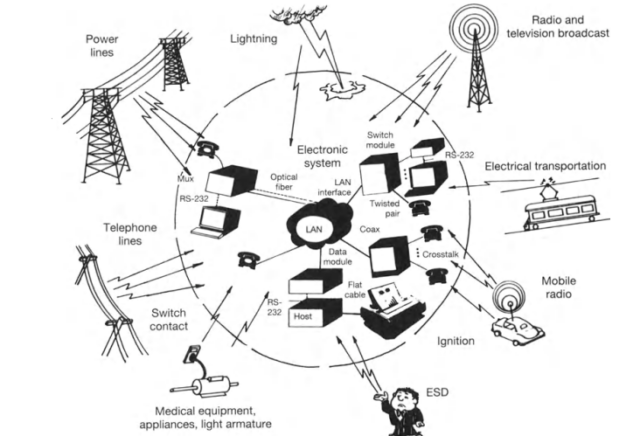Introduction
In the early days of radio and telegraph communications, it was known that a spark gap generates electromagnetic waves that can cause interference or noise in various electronic and electrical devices such as radio receivers and telephone communications.
Other sources of electromagnetic emissions such as lightning, relays, DC electric motors, and fluorescent lights also generate electromagnetic waves that can cause interference in those devices. These sources of electromagnetic emissions contain narrow band of frequencies. High-voltage power transmission lines generate electromagnetic emissions at the power frequency, 60 Hz or 50 Hz.
Definition of Terms
Electromagnetic Compatibility (EMC) is the ability of an equipment or system to function satisfactorily in its electromagnetic environment without introducing intolerable electromagnetic disturbances to anything in that environment.
Other important notes about Electromagnetic compatibility are:
A condition of the electromagnetic environment such that, for every phenomenon, the disturbance emission level is sufficiently low and immunity levels are sufficiently high so that all devices, equipment and systems operate as intended.
Achieved only if emission and immunity levels are controlled such that the immunity levels of the devices, equipment and systems at any location are not exceeded by the disturbance level at that location resulting from the cumulative emissions of all sources and other factors such as circuit impedances. Conventionally, compatibility is said to exist if the probability of the departure from intended performance is sufficiently low. See Clause 4 of IEC 61000-2-1.
Compatibility may be understood to refer to a single disturbance or class of disturbances.
A term used also to describe the field of study of the adverse electromagnetic effects which devices, equipment and systems undergo from each other or from electromagnetic phenomena
EMC Environment
A system is electromagnetically compatible with its environment if it satisfies three criteria:
- It does not cause interference with other systems.
- It is not susceptible to emissions from other systems.
- It does not cause interference with itself.
Designing for EMC is not only important for the desired functional performance; the device must also meet legal requirements in virtually all countries of the world before it can be sold. Designing an electronic product to perform a new and exciting function is a waste of effort if it cannot be placed on the market.
EMC is concerned with the generation, transmission, and reception of electromagnetic energy. A source or emitter produces the emission (generation), a transfer or coupling path transfers (transmission) the emission energy to a receptor (reception), resulting in either desirable or undesirable effect. Interference occurs if the received energy causes the receptor to behave in an undesirable manner.
EMC design techniques and methodology have become as integral a part of a design and a fundamental part of an electrical engineer's background. There are three ways to prevent interference:
- Suppress the emission at its source.
- Make the coupling path as inefficient as possible.
- Make the receptor less susceptible to the emission.
The four basic EMC problems:
- Radiated emissions
- Radiated susceptibility
- Conducted emissions
- Conducted susceptibility
Electromagnetic Interference (EMI)
There are few of the important coupling modes involved in electromagnetic interference (EMI) as well as some EMI regulations. The worst case electromagnetic emissions found in the environment. This data is useful in evaluating the severity of a given electromagnetic environment and in predicting electromagnetic compatibility (EMC) for equipment operated in these environments.
Effects of EMI
The effects of EMI are extremely variable in character and magnitude ranging from simple annoyance to catastrophe.
Some examples of the potential effects of EMI are:
- Interference to television and radio reception
- Loss of data in digital systems or in transmission of data
- Delays in production of equipment exhibiting intra-unit, subsystem or system level EMI
- Malfunction of medical electronic equipment (e.g. neonatal monitor, heart pacemaker)
- Malfunction of automotive microprocessor control systems (e.g. braking or truck anti-jackknife systems)
- Navigation equipment malfunction
- Inadvertent detonation of explosive devices
- Malfunction of critical process control functions (e.g. oil or chemical industry)
To correct EMI problems occurring after equipment is designed and in production is usually expensive and results in program delays which may adversely effect the acceptance of a new product. It is preferable to follow good EMC engineering practice during the equipment design and development phases. The goal is to produce an equipment capable of functioning in the predicted or specified electromagnetic environment and which does not interfere with other equipment or unduly pollute the environment. That is, to achieve EMC.
The techniques of EMC will adversely effect the acceptance of a new product. It is preferable to follow good EMC engineering practice during the equipment design and development phases. The goal should be to produce equipment capable of functioning in the predicted or specified electromagnetic environment and which does not interfere with other equipment or unduly pollute the environment, that is, to achieve EMC.
The techniques of EMC prediction will aid in meeting the goal of EMC when applied at the design stage. These techniques of analysis and modeling are applicable to EMI control and problem solving or in the location of out of specification emissions. It is in the area of emission reduction where analysis is most likely to be supplemented by measurement and diagnostic intervention.
